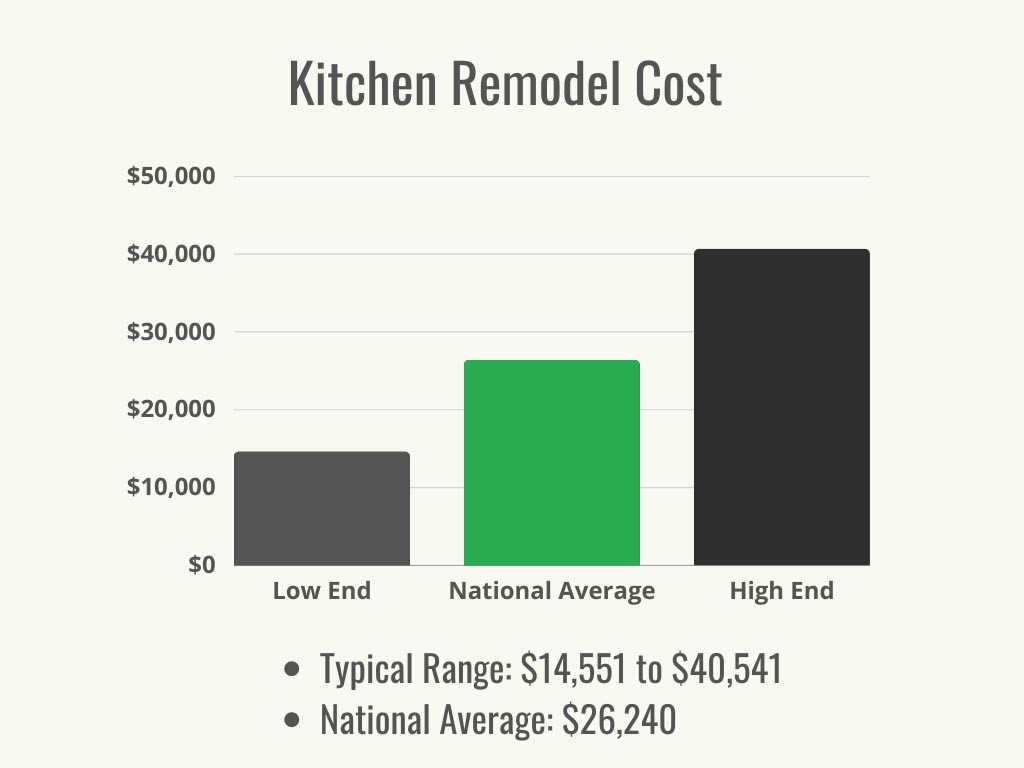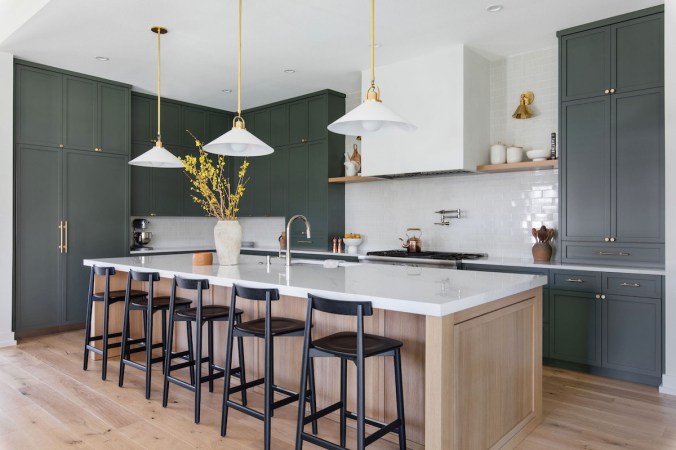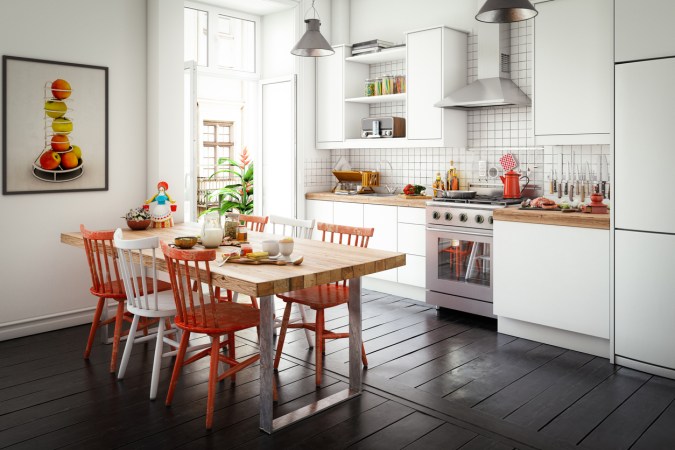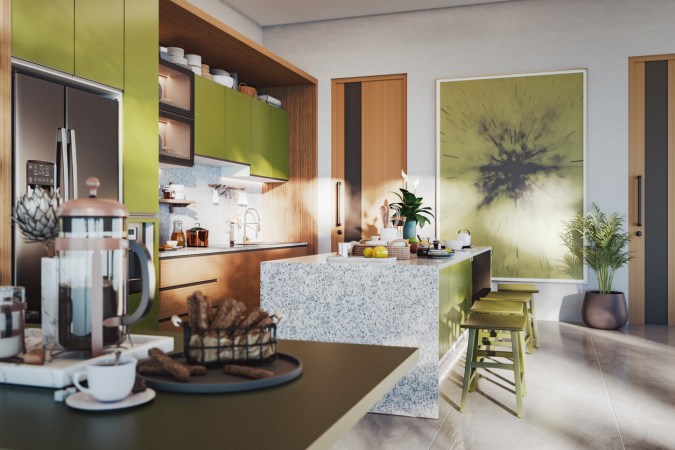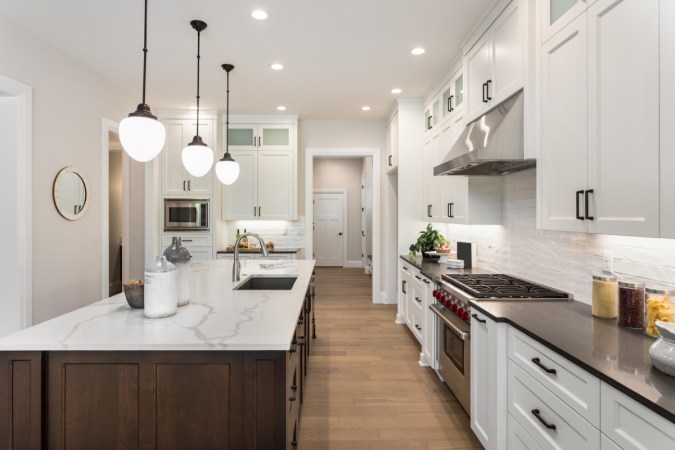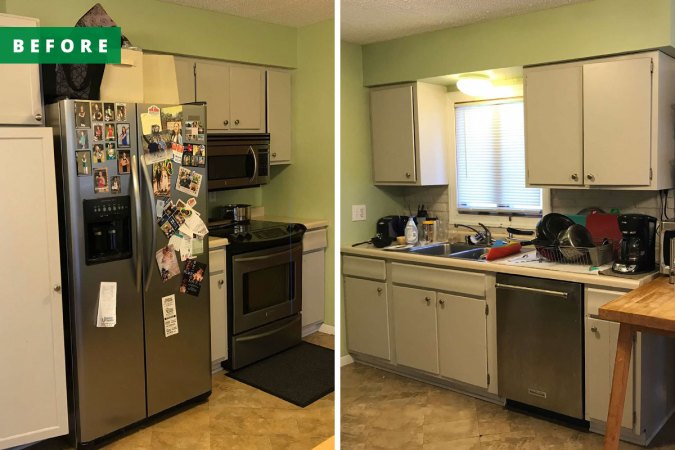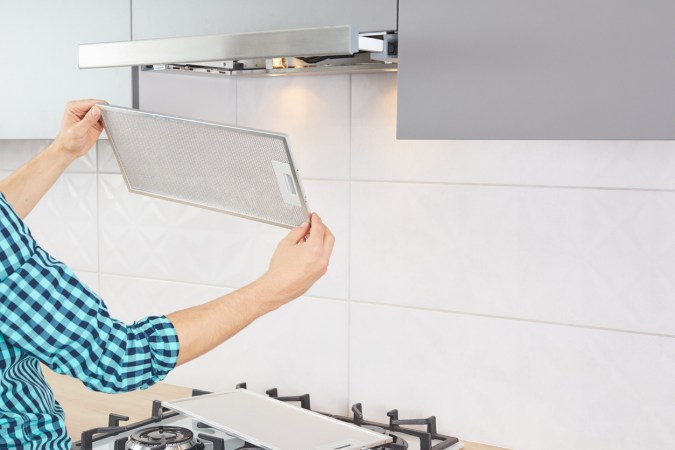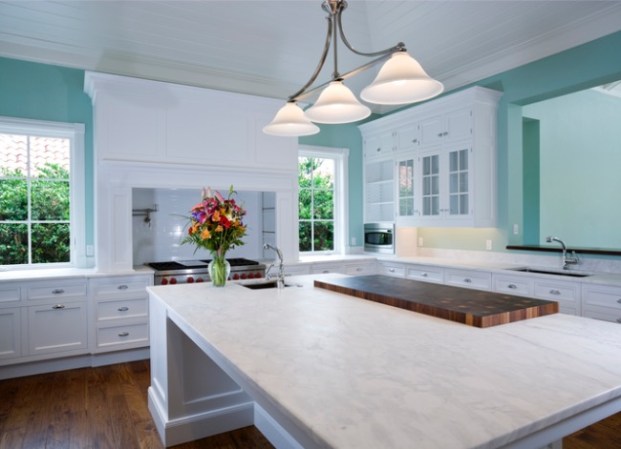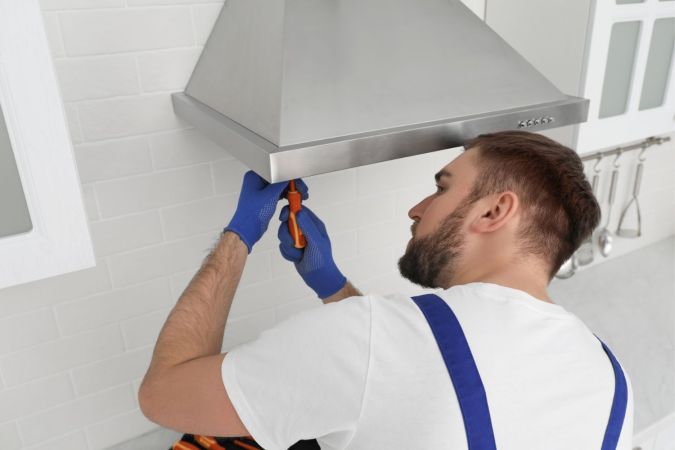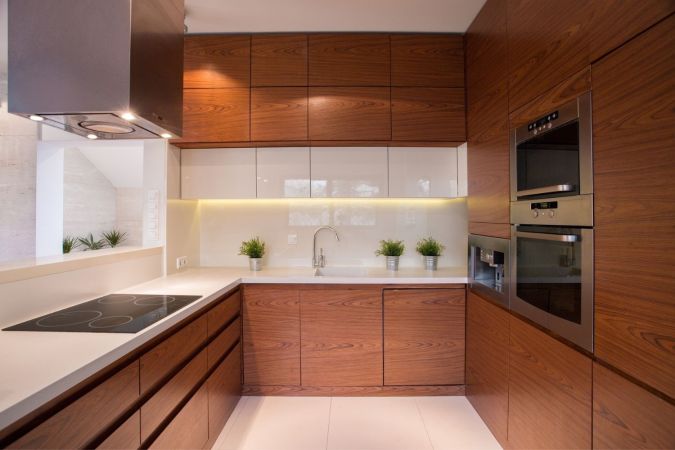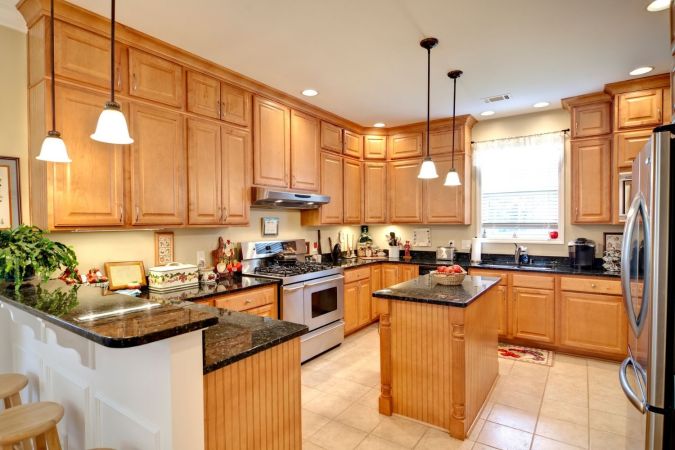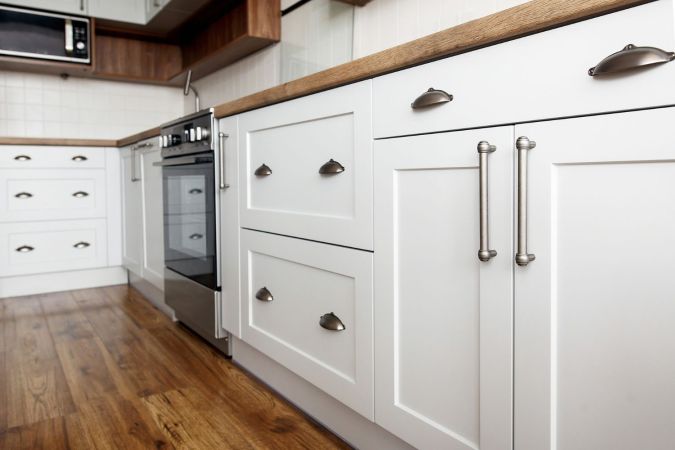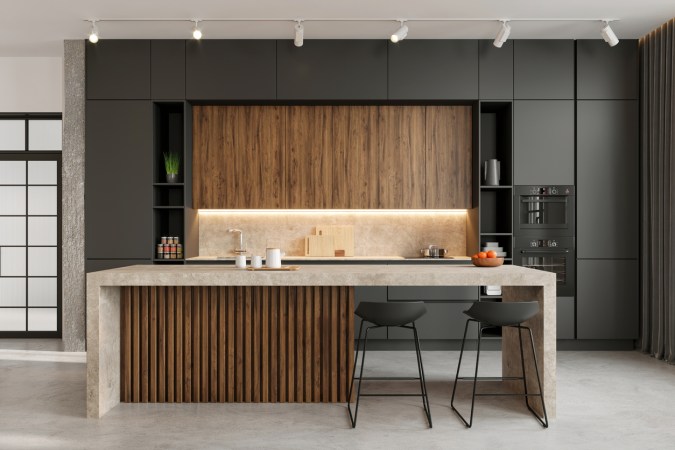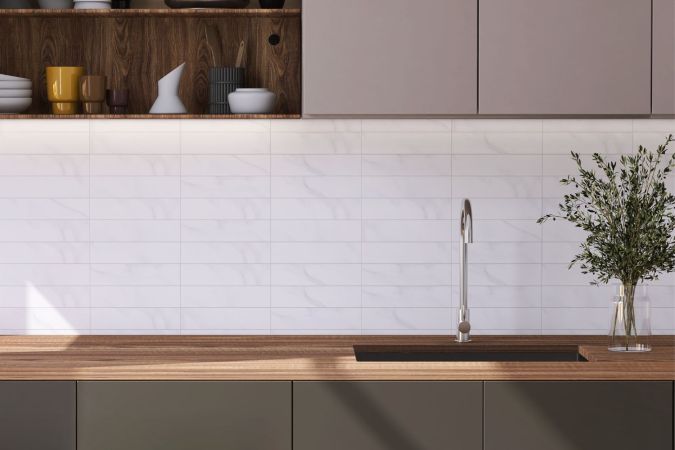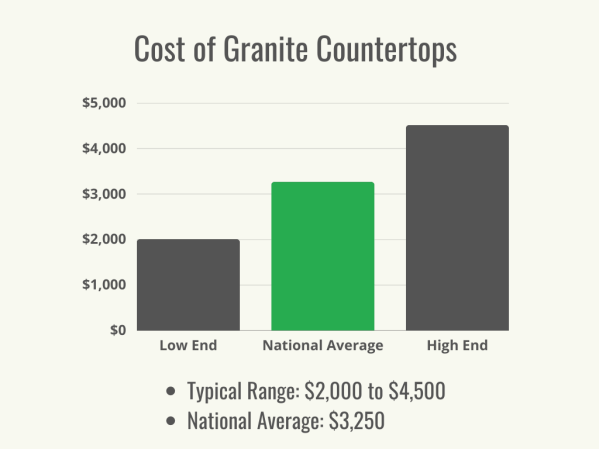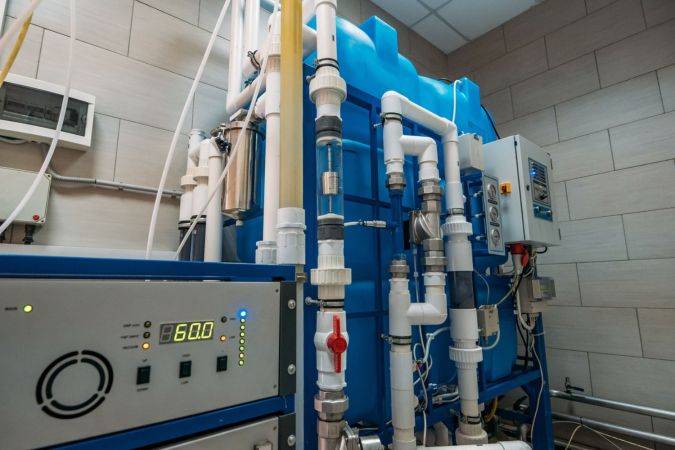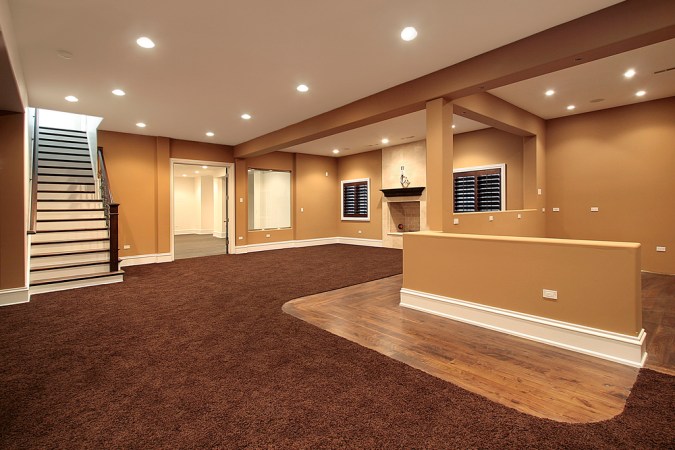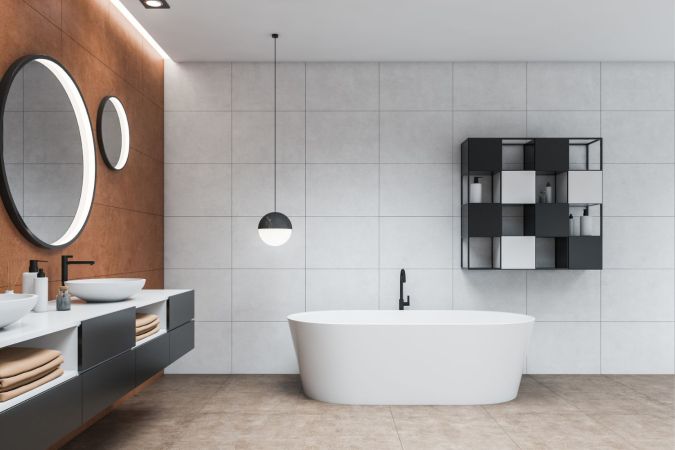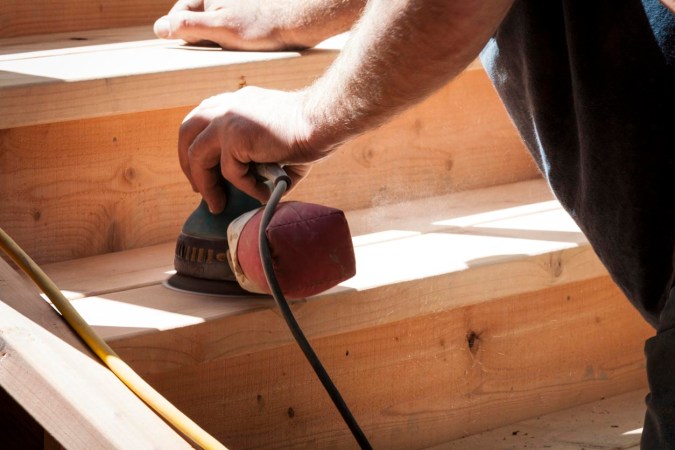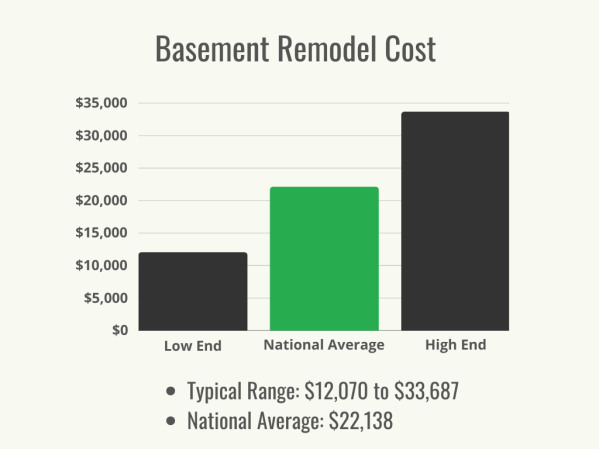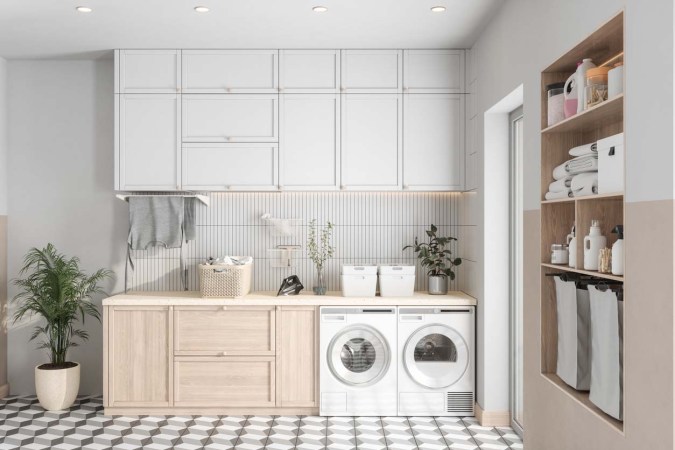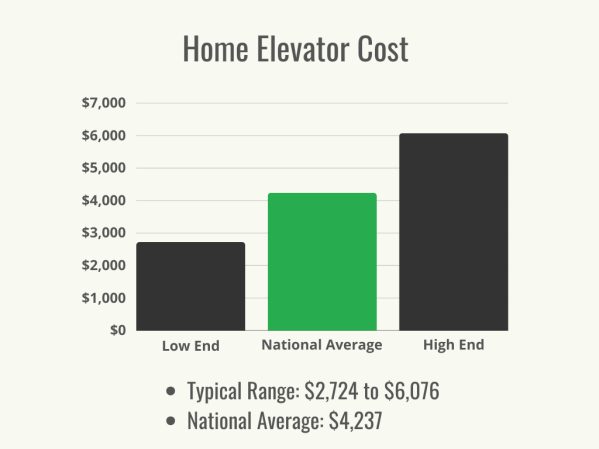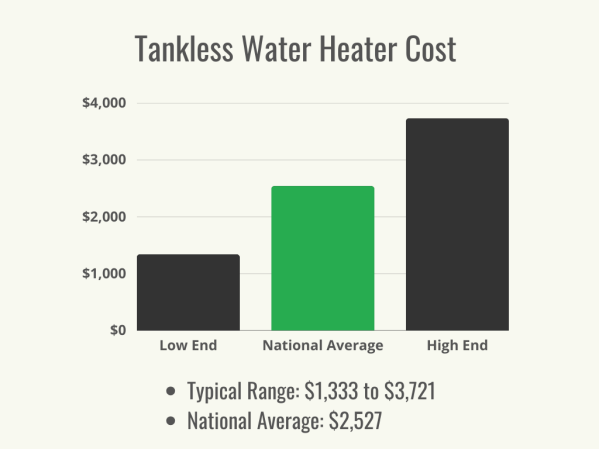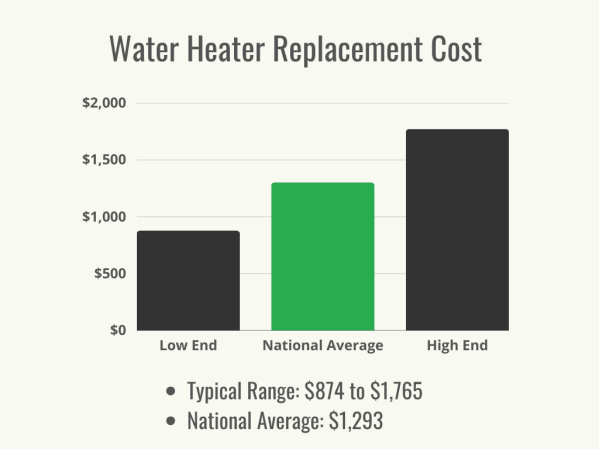We may earn revenue from the products available on this page and participate in affiliate programs. Learn More ›
Highlights
- Kitchen remodeling typically has a cost range of $14,551 to $40,541, with a national average of $26,240.
- The main factors affecting the price to remodel a kitchen include the kitchen size, project scale, labor costs, geographic location, and the choice of materials.
- A kitchen remodel can make the kitchen more functional, provide more storage space, improve energy efficiency, and increase home value.
- Kitchen remodeling is a job best left to an experienced remodel contractor, as it requires extensive construction, plumbing, and electrical work.
In many homes, the kitchen is a hive of daily activity: Many homeowners and families spend a good chunk of their day there, cooking, eating, chatting, packing lunches, and so on. Out of necessity, kitchens also have long-wearing fixtures and finishes, so in the busyness of everyday life, it’s easy not to notice that a kitchen is slowly aging—until something cracks, breaks, or is suddenly so dingy that kitchen remodeling is necessary. A kitchen makeover, even if it’s a simple refresh, can make time spent at home feel better. But how much does the average kitchen remodel cost?
Kitchen remodels are large projects and can have significant budgets. According to Angi and HomeAdvisor, the typical cost range to remodel a kitchen is $14,551 to $40,541, with a national average cost of $26,240, so it’s important for homeowners to really think through the possibilities before making a plan, purchasing materials, and hiring a contractor. These steps can help homeowners decide what scale kitchen remodel they need and determine a budget that is reasonable to get the kitchen they want while maximizing their return on investment.
Remodel vs. Renovation vs. Expansion
When researching “kitchen renovation” or “kitchen remodeling cost,” homeowners will run across several terms with the same meaning or similar ones. Homeowners who are planning to work with a contractor will want to make sure they know what they’re asking for by clarifying the lingo of the kitchen project.
Remodel vs. Renovation
What is the difference between a kitchen remodel and a kitchen renovation? The two terms are often used interchangeably by salespeople and contractors, though they are not the same. A renovation is a project that returns a space to a new state; it restores a space to look like new, cleaning up finishes, taking care of repairs, and sometimes replacing basic fixtures that have stopped functioning well. A remodel is a larger project that often includes replacing flooring, walls, and ceilings, and it can also involve moving the plumbing and electrical connections in a room.
By these definitions, the average price of a kitchen remodel will be significantly higher than the price of a renovation. However, the dictionary definition doesn’t matter as much as the definition used by the contractors a homeowner may interview prior to hiring one. Rather than assuming that the contractor is on the same page, it’s best to clarify exactly what they mean by “renovation” or “remodel.” Laying everything out on the table right at the beginning prevents confusion (and potentially unexpected costs) later in the project.
Expansion
Expanding a room goes a step beyond renovating or remodeling. This type of project includes reframing a space, removing walls, and increasing the overall footprint of a kitchen. Often, an expansion involves combining an unused formal dining space with a smaller kitchen to create a more expansive cooking, eating, and gathering space that is better suited to the family’s lifestyle, or incorporating a kitchen into a great room for a more open floor plan. Expanding a space comes with a higher price tag because of all of the plumbing, electrical, and framing work that is involved.
Factors in Calculating Kitchen Remodel Cost
Homeowners who look up “cost of kitchen remodel” will likely find there is not a one-size-fits-all answer. One of the best kitchen remodeling tips is for homeowners to establish a budget early in the project. Having an idea of the overall maximum budget and allowing a percentage to cover unexpected surprises will leave homeowners room to tailor choices during the process of selecting materials to fit that budget. Using a kitchen remodel cost estimator can help provide homeowners with a ballpark estimate to work from.
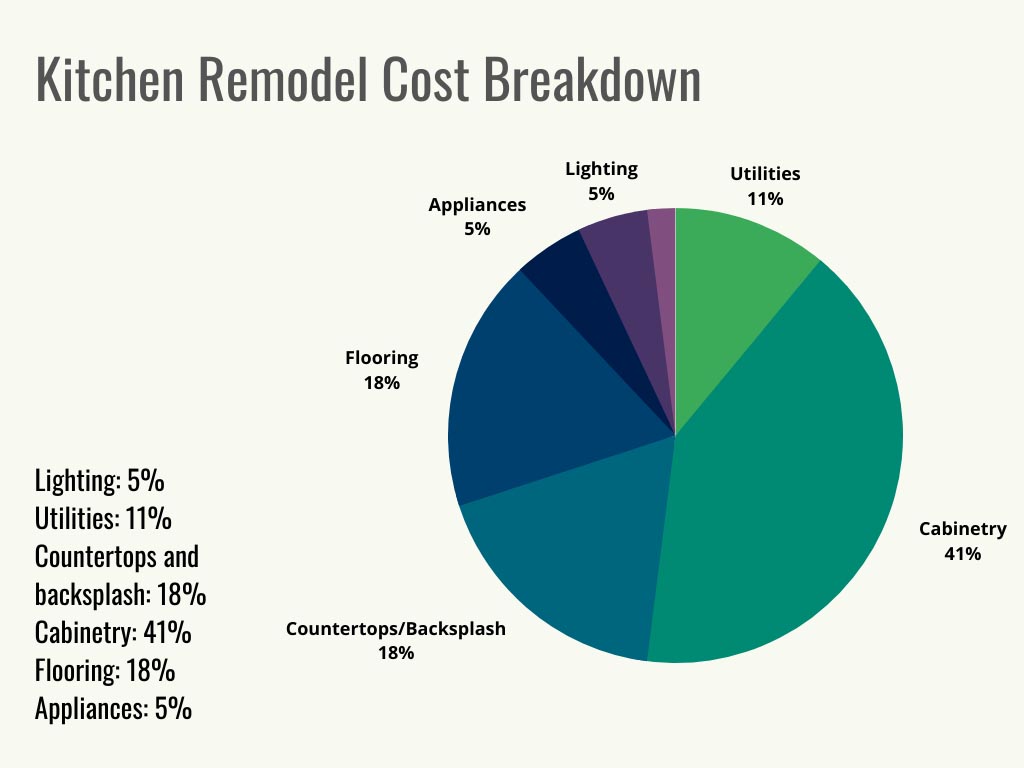
Kitchen Size
The square footage of the kitchen affects all of the numbers in the budget. Larger spaces require more drywall, more flooring, more paint, and more cabinets. In general, the cost to remodel a kitchen is around $150 per square foot.
| Project Scope | Average Cost |
| Small-scale remodel | $10,000 to $20,000 |
| Mid-scale remodel | $20,000 to $70,000 |
| Large-scale remodel | $70,000 to $130,000 |
Installation and Labor
Installation and labor costs for a kitchen remodel average out to between $3,500 and $6,000, accounting for 18 percent of the total project budget. This is a negotiable cost, depending on what work a homeowner may be able to complete themselves and the contractor’s willingness to reduce the fee in exchange for the help. In general, homeowners can expect to spend $2,500 on installation for every $10,000 of the total remodel cost.
Doors and Windows
Doors and windows are another variable cost factor, depending on the configuration of the kitchen. In general, they can account for about 4 percent of the budget, or about $1,200 on average. In a kitchen that opens to a deck, this will be a larger portion of the budget, while in an open-plan kitchen with no windows or just a small one, it may be less. Window installation can cost between $300 to $1,200 per window; interior door installation can cost between $360 to $1,170 per door; and exterior door installation can cost between $510 and $1,790 per door.
Cabinetry and Countertops
The largest portion of the kitchen remodel budget usually goes to cabinetry and hardware. As the most visible and substantial feature of the kitchen design, cabinetry will often determine the style, color palette, and level of detail in the rest of the kitchen. Therefore, 28 percent of the budget, an average of $8,400, will typically go to the cost of kitchen cabinets and hardware. Depending on the number, material, and style of cabinets, homeowners can expect to pay between $2,000 and $30,000.
Approximately 11 percent of a kitchen remodel budget can be set aside for hiring one of the best countertop installers. The national average places that dollar figure at around $3,300, but the cost will depend on the homeowner’s choices of material (for example, the cost of granite countertops is significantly higher than the cost of laminate) and on the total square footage of countertops needed in the kitchen layout.
| Material | Average Cost |
| Concrete | $2,100 to $4,000 |
| Stainless steel | $4,000 to $11,250 |
| Soapstone | $2,700 to $4,200 |
| Paper composite | $2,500 to $6,000 |
| Corian | $2,200 to $5,000 |
| Solid surface | $1,950 to $4,920 |
| Granite | $2,250 to $4,500 |
| Bamboo | $2,000 to $3,000 |
| Recycled glass | $1,800 to $3,750 |
| Quartz | $1,500 to $12,000 |
| Marble | $2,000 to $5,000 |
| Tile | $480 to $1,950 |
| Laminate | $790 to $1,630 |
| Wood | $600 to $12,000 |
Custom edge routing, honing of natural stone, and the shape and number of cuts will also affect the cost of countertops. As it is one of the most eye-catching and often-used features in a kitchen, the countertop is an area where homeowners often choose to splurge on higher-end material, but if there are other priorities in the remodel, a lower-grade choice can help save money.
Backsplash
The cost of backsplash installation can run anywhere from $600 to $1,300 for an average remodel and up to $10,000 for a larger and more complex project. The price will vary depending on the size of the backsplash, the materials, and labor. Some experienced DIYers feel comfortable installing a simple tile backsplash themselves, but for those who do not have tiling experience or want a more elaborate pattern, it may be worth it to let a contractor handle the installation.
| Material | Cost per Square Foot |
| Brick | $10 to $40 |
| Stainless steel | $20 |
| Glass | $30 |
| Tile | $25 |
| Marble | $10 to $95 |
| Tin | $10 to $30 |
Flooring
As with countertops, there are myriad material options in kitchen flooring. Sheet vinyl and vinyl tile, linoleum, and laminate flooring are, in general, the least expensive options, and modern versions of these materials are quite durable and attractive. Ceramic tile and wood, followed by natural stone, are more expensive, and alternative flooring options such as cork and concrete provide additional choices. Kitchen flooring costs range from $1,000 to $4,000 and make up an average of 18 percent of the total budget. The best kitchen flooring will likely be different from homeowner to homeowner.
| Material | Cost per Square Foot |
| Vinyl | $1 to $7 |
| Linoleum | $4 to $7 |
| Laminate | $3 to $10 |
| Ceramic tile | $4 to $40 |
| Hardwood | $6 to $12 |
| Stone | $6 to $20 |
Lighting
Lighting is a factor that homeowners often underestimate when creating a kitchen remodel plan and budget. Kitchens have multiple lighting options and requirements, and while an attractive fixture in the ceiling and a pendant over the sink are helpful for adding ambient lighting, the real workhorses of the kitchen lighting scheme are the task lights: lighting that focuses on the spot where the cook stands to chop vegetables or the area over the stove, or that illuminates the eating area. Lighting costs around $500 to $2,000, and homeowners are advised to have the lighting plan fill about 5 percent of their planned kitchen remodel budget.
Walls and Ceiling
Refreshing the existing walls and ceiling with paint or wallpaper is an option in any kitchen remodel, but sometimes new materials provide extra benefits that make them worth replacing. New fire- and moisture-resistant drywall can add safety features, while paneling or tongue-in-groove ceilings can change the feel of a kitchen. Drywall costs between $12 and $20 per panel, and painting a kitchen costs from $300 to $750 total. About 5 percent of the budget will usually go to the walls and ceiling, which translates into an average of $1,500.
Faucets and Plumbing
If the layout of the kitchen remains largely unchanged, plumbing costs will be minimal, as the water and gas lines can remain in place. Changing up the look will increase the material and labor costs for plumbing to the higher end of the range. New faucets can brighten and refresh the appearance of the kitchen for relatively minimal cost; faucets cost from $160 to $360 to install, and a new sink costs $220 to $630. Replacing faucets and plumbing costs around 3 percent of the remodel cost.
Appliances
At the heart of the kitchen are its appliances, typically including a refrigerator, oven and cooktop or range, dishwasher, microwave, and potentially a ventilation hood. Often, remodelers look to reuse some existing appliances, which is a great option if they are reasonably new. If, however, some appliances need replacement, it’s worth noting that the best appliance deals usually come as a package; the more appliances purchased together, the greater the overall savings.
This approach may mean a higher up-front cost, but in the long run, it will offer significant savings. The cost of appliances can vary greatly, from as little as $100 each to as much as $5,000 or more, depending on the type and quantity. If the homeowner hires a professional to install their appliances, they can expect to pay between $120 to $270 per appliance in labor costs.
High-end, custom built-in options can each cost $10,000 or more. In most cases, the appliances comprise about 15 percent of the total budget, or around $4,500, but again, that number can be skewed by luxury options. Homeowners are also advised to keep in mind that there is additional cost for installation, which on average runs about $120 to $281 per appliance but can vary.
| Appliance | Installation Cost |
| Refrigerator | $150 to $250 |
| Stove, oven, or range | $105 to $125 |
| Range hood | $120 to $500 |
| Microwave | $70 to $500 |
| Exhaust fan | $70 to $105 |
| Dishwasher | $110 to $270 |
| Appliance packages | $260 to $550 |
| Smart appliances | $70 to $500 |
Storage and Organization
Homeowners who find themselves stashing groceries on top of the refrigerator or whose countertops are cluttered with appliances will likely want to factor additional storage into their remodel plan. This could include a walk-in pantry, additional cabinets, deeper drawers, or more options depending on budget and square footage. For reference, the cost to add a new pantry typically falls between $1,100 and $2,900. In some cases, it may be helpful to have an interior designer share some creative suggestions for how to make the best use of the space.
Geographic Location
There can be significant differences in the cost of materials and labor for a kitchen remodel depending on the region. The Northwest has some of the highest average costs to remodel a kitchen, with an average of $25,600 to $61,100. On the flip side, kitchen remodel price averages $10,500 to $34,300 in the Midwest. Major cities also tend to skew higher in cost, while smaller cities have a lower overall cost.
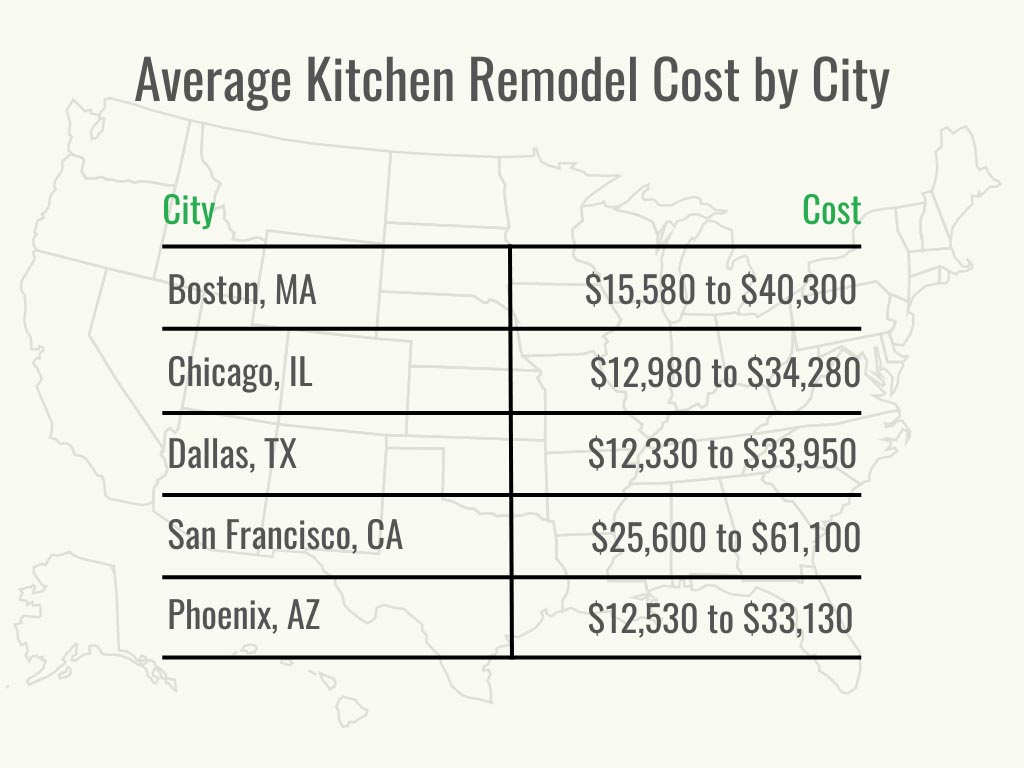
Additional Costs and Considerations
After homeowners make the big decisions about the fun aspects of a kitchen remodel—the parts residents can see—it’s time to factor in the unseen network of pipes and wires that make the kitchen run, along with the cost of the services of a contractor to help plan that network efficiently.
Design Fees
Some homeowners can imagine the kitchen they’re dreaming of perfectly in their mind and are able to use one of the best kitchen design software options to create a plan and save some money. However, it’s still a good idea to hire a professional kitchen designer to draw up a formal plan, confirm measurements, and identify the small but critical items that a homeowner may have missed.
The average kitchen designer will make up about 3 percent of the overall budget, with an average cost of $50 to $200 per hour or $5 to $15 per square foot. This can be even less for the services of a certified in-house designer at a home improvement store; these costs may be folded into the cost of the cabinets and appliances or will be charged as an installation fee and will stay comfortably in the range of $150 to $450 per consultation. This cost can skyrocket if the designer is a certified professional who will work on-site, where the expense can reach between $4,323 and $28,074, or about 10 percent to 20 percent of the total project cost.
Plumbing and Electrical Work
Basic fixture installation costs are not typically a huge component of the budget; a simple faucet installation averages from $160 to $360, and a sink installation can cost between $220 and $630. A general contractor can perform these installations, or a homeowner with basic plumbing know-how may be able to tackle them to save a bit of money. Similarly, electricians charge approximately $50 to $100 per hour for labor, and if the electrical work is handled as part of the demolition process of the existing kitchen, it’s not a huge job.
For major remodels that include changing the floor plan, moving the plumbing lines, or upgrading the electrical system, the cost is likely to climb. Hiring a plumber to install new pipes will cost around $1,180, and the cost to replace wiring and the added expense of rush jobs can be unexpectedly significant. Ideally, homeowners will hire a plumber and an electrician at the beginning of the process to advise and coordinate with the contractor from the start.
Gas Lines
Moving gas lines is not a small expense, running from $270 to $880 on average. Permits, inspections, and qualified plumbers will add to the overall cost. If the location of the oven or cooktop is shifting only a bit, the flexible tubing on a gas line may mean the supply line can stay in place. If the appliances are being fully relocated, homeowners will want to plan to move the lines prior to installing flooring or drywall.
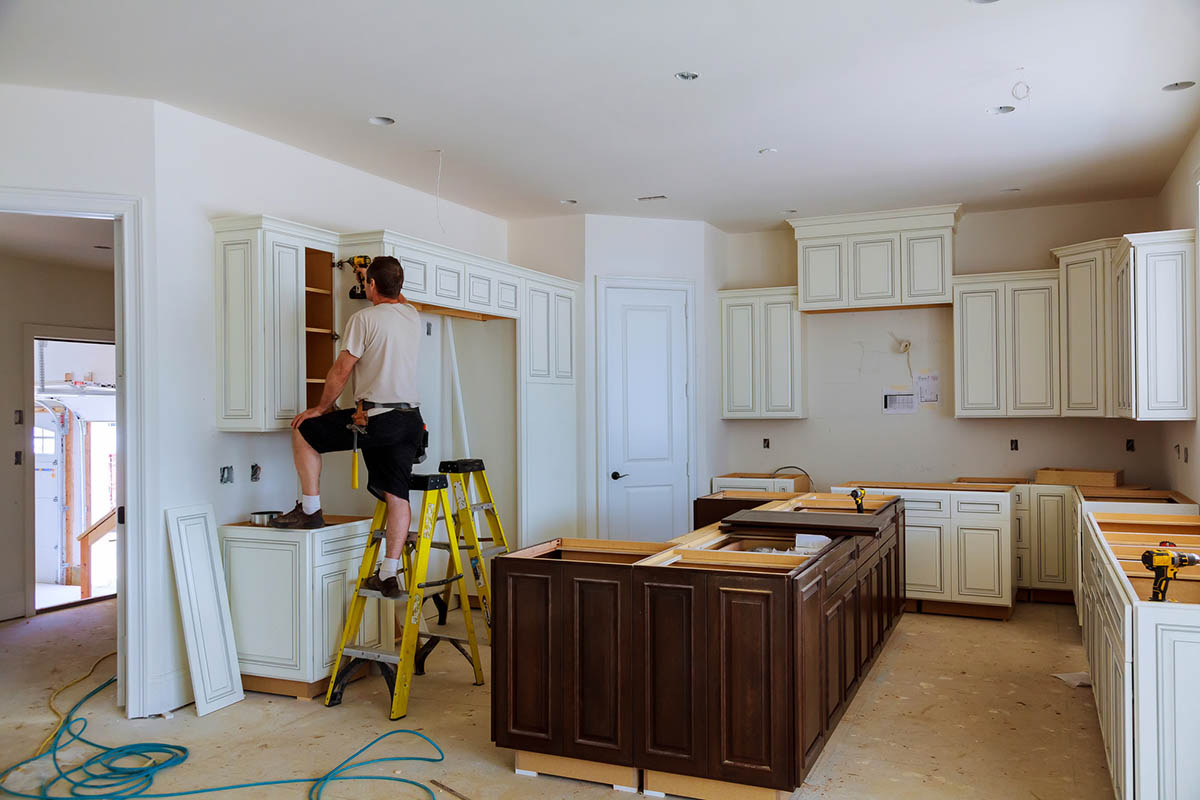
Types of Kitchen Remodels
The ultimate goal of a kitchen remodel is to improve the room’s functionality and visual appeal. Whether this involves a light refresh or a complete gutting of the space will depend on the homeowner’s target budget, time frame, and kitchen size. The average cost of a kitchen remodel will greatly depend on the scope of the project.
| Type of Kitchen Remodel | Average Cost (Materials and Labor) |
| Small | $10,000 to $20,000 |
| Medium | $20,000 to $70,000 |
| Large | $70,000 to $130,000 |
Small
Fortunately, it isn’t always necessary to completely gut the kitchen and start from scratch. If the layout of the kitchen is well designed but some elements are beginning to look dated, or if the kitchen is smaller than 70 square feet, only a small remodel may be needed. Investing in the cost to paint the cabinets, install new countertops, and refresh certain appliances can go a long way. Small kitchen remodel costs typically fall between $10,000 and $20,000.
Medium
For homeowners who can’t commit to a full kitchen makeover but whose space needs more than just a refresh, a moderate kitchen remodel may be the best option. A kitchen that is considered to be medium size is around 150 to 175 square feet. Some ways to keep the project cost efficient could involve leaving the layout of the room intact but updating the flooring, counters, cabinets, or appliances. Another way to save costs might also be to tackle some of the work independently, although it’s important to be realistic about what is a feasible DIY project and what is best left to the professionals. The cost for a medium-size kitchen remodel will usually fall between $20,000 and $70,000.
Large
Homeowners who plan to stay in their home for many years would be wise to optimize the kitchen to their exact preferences. For example, for someone who has never liked the placement of their appliances or who dreams of adding a walk-in pantry, it may be well worth the extra time and cost to have a more functional space in the long run. A kitchen with a lot of square footage (200 square feet or more) will provide a luxurious amount of counter space and storage, but the larger size also means that the cost for labor and materials will be significantly higher. A large kitchen remodel may also require rerouting plumbing or gas lines and possibly some electrical rewiring. Depending on the project, the cost to remodel a large kitchen can be as high as $70,000 to $130,000.
Do I need a kitchen remodel?
A kitchen remodel is no small project—the time and energy required to undergo the remodeling process (not to mention the cost) may cause homeowners to drag their feet. But the longer it is postponed, the longer they’ll be dealing with an unsightly or dysfunctional space. If the kitchen has any of the following problems, it’s probably time for the homeowner to start planning a remodel. Some issues like water damage get more severe and more costly the longer they go unchecked.
Insufficient Storage
When homeowners start finding themselves piling groceries on top of the fridge or losing kitchen tools to junk drawers, this is a pretty good indication that there is insufficient storage in their kitchen. It may be necessary to add cabinets or an extra pantry to accommodate food items and cooking tools. Even if expanding the size of the kitchen isn’t possible, creatively reworking the space to be more efficient can do wonders.
Outdated or Broken Appliances
Even the most high-end appliances wear out eventually, and when they do, they can become inefficient and even dangerous. Once a range begins to heat unreliably or a refrigerator won’t stay cold, the appliance is likely reaching the end of its life cycle. If the appliances were all installed at the same time, they may even start giving out one right after the other. While replacing each appliance is pricey, it’s likely that the decrease in energy bills—and the potential savings from purchasing several items at once—will make it more worthwhile for homeowners.
Broken Cabinets or Tiles
Kitchen cabinets see a lot of action, and it’s normal for them to wear out over time. Sometimes the hinges loosen or fall off, the wood splinters, or they just become dingy. Similarly, tile floors and backsplashes get chipped or broken from use. Not only can these problems give the kitchen a lackluster appearance, but it’s possible for a loose cabinet or sharp tile chip to cause an injury if left in disrepair.
Cracking or Peeling Floor
Kitchen floors are especially vulnerable to damage due to heavy traffic and excessive heat and humidity. If the floor’s linoleum is coming unglued or the tile is starting to crack, it’s time to replace it altogether.
Cracked or Shifting Countertops
Homeowners don’t typically consider how much they use countertops until they start to chip or crack. Just like a cracked plate or mug can harbor bacteria, cracks in a granite countertop can be home to germs as old food gets stuck in the crevices. Other times, a counter can even start to separate from the wall or its base over time, causing it to become unstable. It’s important for a homeowner to take care of this immediately to keep it from collapsing altogether.
Water Damage
It’s not uncommon for older kitchens to suffer from water damage, whether it’s a ceiling pipe that has sprung a leak or a drip under the sink that has gone unnoticed. Over time, this can damage drywall and cabinets and create the perfect conditions for mold to grow. If the damage is severe enough, it may take significant repairs to get the space back to a functional and sanitary state.
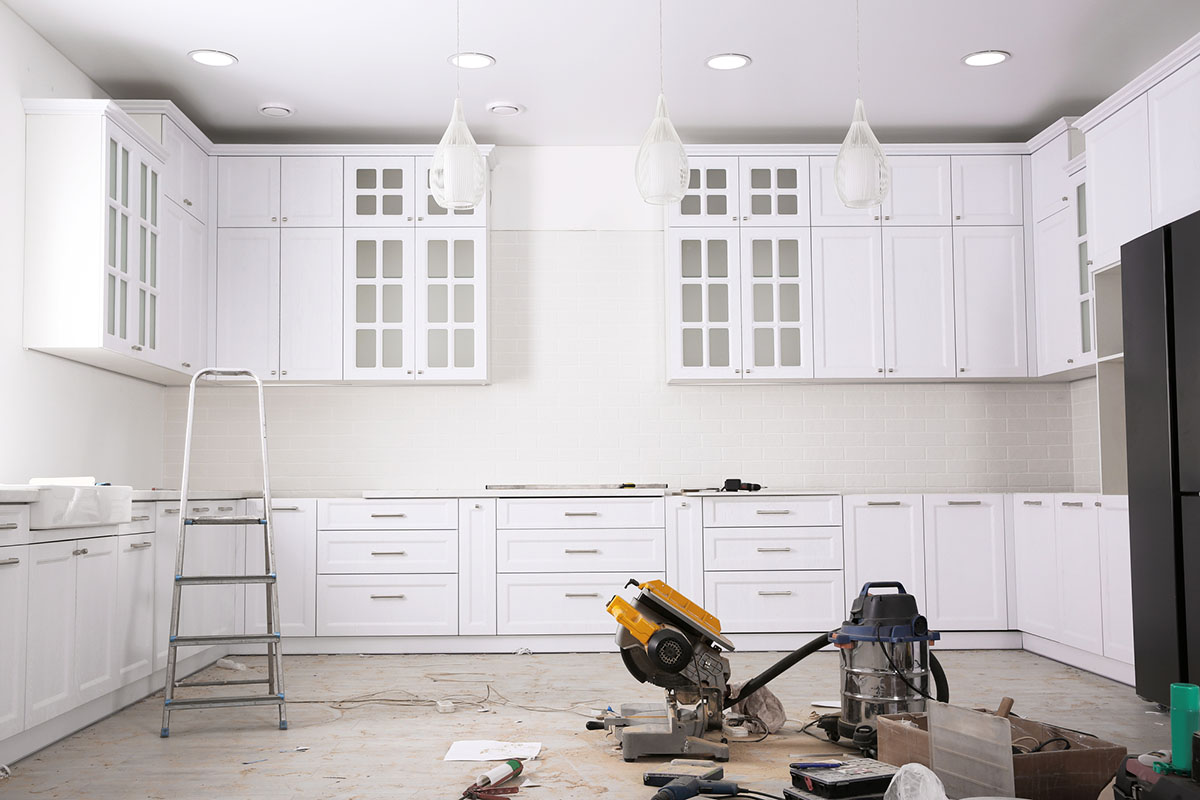
Benefits of a Kitchen Remodel
Some of these numbers are big—some kitchen remodels may require financing or saving before taking the plunge. A homeowner may be wondering whether it’s worth it to remodel the kitchen at all. Beyond the appeal of designing a dream kitchen and making necessary repairs, there are other significant and long-term benefits to remodeling the kitchen.
Increased Home Value
Kitchen remodels are a huge benefit for both buyers and sellers because they provide one of the best returns on investment (ROI) of any home improvement project. Experts estimate that a quality remodel can recoup between 57 percent and 78 percent of the project cost by increasing the value of the home. The best way for a homeowner to maximize the increase in home value is to work with a contractor or design professional who can guide these choices to maximize their impact.
Increased Functionality
Many older kitchens were designed with one cook in mind, while in many households today there may be several people congregating in the kitchen at once. Adding work spaces, dedicated storage for appliances, and creative spaces for appliances that are used daily can reduce the time spent preparing and cleaning up meals and allow for better use of shared space.
Modernized Appearance
If a kitchen was very trendy when it was last decorated, it probably feels like it has a date stamp on it, and if it’s not a popular trend, this can make an update feel urgent. A remodel is an opportunity to bring the kitchen into a more contemporary style and to reflect current trends or choose a timeless, classic look that will age well.
Improved Energy Efficiency and Sustainability
Older appliances use far more water, gas, and electricity than they really need. Energy-efficient models will lower utility bills and are kinder to the planet, as are many of the sustainable options for flooring, countertops, and cabinetry.
Improved Safety
Adding ground fault circuit interrupter (GFCI) outlets to a kitchen reduces the likelihood of electrical shocks in a place where water and electricity are often side by side. Many older kitchens are not up to current codes, so updating and acquiring the necessary permits to modernize the safety of the kitchen will increase both the home’s safety and value (homeowners are advised to keep in mind that permits are a hidden cost associated with common remodeling project costs).
Kitchen Remodeling: DIY vs. Hiring a Professional
A kitchen remodel, whether big or small, is a huge undertaking with a lot of moving parts. Homeowners who search for “kitchen remodel labor cost” may try to mitigate the cost by considering parts of the project they can do themselves. But for the vast majority of homeowners, this will be a job for a professional contractor. Even a homeowner who feels confident completing a small portion, like installing tile or painting kitchen cabinets, runs the risk of jeopardizing another part of the project by doing something incorrectly or out of order. The possibility that a contractor will have to be brought in mid-job to handle a challenge of this kind can result in completed work being torn out or budgets soaring past their stop point. And there’s always the possibility of irreparable damage to the home or personal injury.
Working with a carefully chosen contractor buys homeowners access to professional resources and suppliers (which can save both hassle and money), assures polished results, and results in a job completed more quickly. Most importantly, leaving the potentially dangerous elements of a remodel such as plumbing and electrical work to the pros will ensure that these aspects of the project are completed safely and effectively. Of course, there’s the possibility of conflicts with the contractor, but asking the right questions and checking references before hiring one is likely to alleviate the chance of that happening.
How to Save Money on Kitchen Remodel Cost
As with any project, costs can add up more quickly than homeowners may have expected when they first searched “How much does a kitchen remodel cost?” Many of the opportunities to save on kitchen remodeling costs are in the selections made during planning—deciding on economy-, middle-, or luxury-grade materials; choosing lower- or higher-end appliances; and negotiating with contractors or suppliers.
- Keep the remodel simple. If feasible, maintain the footprint of the existing kitchen as much as possible. This will save on building costs as well as plumbing and electrical work.
- Take on some of the work. If you have the skills to perform some of the labor yourself, such as demolition, cabinet installation, or painting, negotiate with the contractor to see if the labor costs can be reduced in exchange for your work.
- Choose stock cabinets instead of custom. Unless you have an odd space to fill, custom will almost always be more expensive.
- Ask about refacing the cabinets instead of replacing them. If you’re happy with the layout of the cabinets and want to upgrade the appearance, refacing can offer a significant cost savings.
- Shop around. Hunt down lower costs on everything from flooring to light fixtures and cabinet pulls by looking in specialty shops, salvage stores, online sale sites, and local resale shops.
- Choose a budget and stick to it. If a particular component is important enough to spend more than you anticipated on it, decide where else you can sacrifice to stay within the budget.
- Plan for contingencies. If you’re opening up the walls, there’s always a potential that you’ll find something that unexpectedly needs repair or replacement. Discuss those possibilities with your contractor and include them in the budget—as much as $3,000 to $5,000.

Questions to Ask About Kitchen Remodeling
A trusted general contractor can be an invaluable partner in the remodeling process, helping keep everything in perspective and keeping much of the stress at bay. To choose the right contractor, homeowners can ask friends, relatives, and neighbors for recommendations; ask the contractor for references; actually call the references; and hire the contractor whose style and manner feel like the best fit. Homeowners will also want to ask several important questions to each professional they’re considering hiring.
- Are you licensed and insured? Do you have liability insurance?
- Who hires the subcontractors? How many subcontractors will there be? Will I have a say in those decisions?
- Does the contract include material costs and permit costs, or are those itemized separately?
- What is the down payment? Is it negotiable? What is the payment structure after the down payment?
- What is the anticipated timeline for the project? What might change the timeline?
- Will I be able to remain in the house for the duration of the project?
- Do you have photographs of work you’ve done on a kitchen remodel near me?
- Can you provide contact information for references nearby?
- What challenges do you foresee in my project? How will those be handled?
- Do you work with multiple suppliers and brands of appliances, cabinets, and flooring, or are the options limited to specific companies with which you’re affiliated?
- Will you be my main point of contact? How can I get in touch with you during the project?
- Can I see an up-to-date business license?
- Are you a member of the Better Business Bureau?
- Do you provide a warranty?
- Do you offer financing?
- Who will oversee project management?
- Will you clean up after the project?
FAQs
Kitchen remodels are exciting, but they can also be a little scary and overwhelming with so many important decisions for homeowners to make. Budgeting thoughtfully and deciding on priorities, along with working with carefully chosen professionals, will make the process smoother.
Q. How much should I budget for kitchen remodel?
The first decision for a homeowner to make before creating a budget is to figure out the degree of remodel that they want done. A reasonable budget for a minor remodel using quality but economical materials will be between $10,000 and $15,000, but it may require some DIY work. A midrange remodel, including higher-grade materials and more help from professionals, could be budgeted between $20,000 and $70,000, while a major remodel with high-end appliances, custom cabinetry, and luxury finishes can stretch beyond $130,000. On average, kitchen remodel prices are between $14,572 and $40,532.
Q. How much does it cost to replace kitchen cabinets?
In an average kitchen remodel, replacing the cabinets costs between $4,000 and $13,000, with an average cost of $11,100. The cost could reach as high as $30,000 or more in a high-end kitchen remodel. The cabinet grade and the linear footage of cabinets in the kitchen will affect the total cost.
Q. What is the most expensive part of kitchen remodel?
In general, the cabinets and their hardware are the most expensive component of a kitchen remodel. They account for approximately 30 percent of the overall budget, or about $1,860 to $9,430 on average. There are options for homeowners to make this less expensive: Assembling a collection of stock cabinets and adding molding can be less expensive than having custom or semi-custom work done, and refacing the existing cabinets can vastly reduce the cost. To an extent, the most expensive element of a kitchen remodel depends on what a homeowner prioritizes; custom natural stone countertops can eclipse the cost of basic cabinetry if that’s the homeowner’s decor priority.

